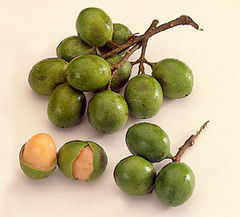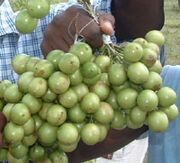
Mamoncillo
Name Variations[]
- Guinep
- Genip
- Ackees (in Barbados)
- Spanish lime
- Limoncillo
- Mamon
- Mamoncillo
About Mamoncillo[]
Wikipedia Article About Mamoncillo on Wikipedia
A small oval green-colored fruit grown on trees related to the Evergreen family. This fruit typically grows in clusters of twelve or more from a single stem. Similar in shape and size to an large green olive, the outer flesh of the Mamoncillo is hard and brittle. It is easily peeled away to expose a pinkish to cream colored flesh, which provides a very sweet tasting meat. Also known as a Spanish Lime, this fruit is often served in beverages like a lime, or served as a fresh flavored snack to eat out of hand.
Melicoccus bijugatus, also known as the Mamón (although the word is considered obscene in some Spanish speaking countries), Chenet, Genip, Guinep, Kinnip, Quenepa or Spanish Lime, is a fruit-bearing tree in the soapberry family Sapindaceae, native to a wide area of the American tropics including Central America, Colombia, Venezuela, and the Caribbean. It is a large tree growing up to 30 m high. The leaves are alternate, 8–15 cm long, pinnate with 4 or 6 opposite leaflets (no terminal leaflet), each leaflet 5–10 cm long.
It is grown and cultivated for its ovoid, green fruit, which grow in bunches. The fruit ripen during the summer. The fruit, similar to that of the related Lychee, is classified as a drupe. A mamoncillo fruit has a tight and thin but rigid layer of skin, traditionally cracked by the teeth. Inside the skin is the tart, tangy, yellow pulp of the fruit, which is sucked by putting the whole fruit inside the mouth (the seed takes most of the volume of what is inside the skin). The stains on clothing from the pulp take a brownish color and cannot be removed; the stains are permanent.

Ginuep
A small, grape-like fruit with a green skin and a large seed surrounded by a thin layer of sweet, fleshy pulp. Each mamoncillo fruit has a large seed inside, the same ovoid shape as the fruit itself. Mamoncillo seeds can be roasted and eaten just like sunflower seeds or chestnuts.
The mamoncillo has small, greenish-white, fragrant flowers in panicles. They begin to blossom from the branch tips when the rainy season begins. The mamoncillo is an example of a polygamous plant, producing bisexual flowers as well as flowers that are exclusively male or exclusively female. Occasionally, a bisexual flower will have a "dud" (sterile) anther, which limits the number of fruits produced from self-pollination when cross-pollination is possible.
Being tropical, the mamoncillo prefers warmer temperatures. Its leaves can be damaged if the temperature hits freezing point, with serious damage occurring below -4 °C. Gardeners of mamoncillos should occasionally give their plants heavy watering during the summer and propagate via seeds; grafting is also used to propagate cultivars.
The Mamoncillo is also commonly planted along roadsides as an ornamental tree.
There are 10 species in this genus, some of which also have edible fruits such as Melicoccus lepidopetala, native to Bolivia, Paraguay and Argentina, and Melicoccus oliviformis native to northern South America, Central America, and the Caribbean.
